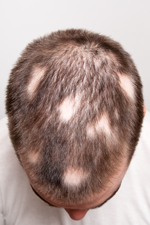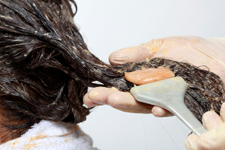Legal case example 7
Alopecia Areata
On this occasion the Claimant has just vacated his seat in his lounge to retire for the night and was stood at the door to the hallway, when a motor car came crashing through the wall of his home and into the lounge, where he had just been sitting! The Claimant had to vacate his home for a period of 6 months, whilst the repairs to his home were completed.
One month after the incident, the Claimant's hair began to shed excessively leaving small, circumscribed patches of hair loss. The Claimant suffered such severe shock that it had precipitated a condition known as Alopecia Areata. The Claimant had never suffered from such a condition previously.
At the time of my examination, some 12 months later, the Claimant's scalp showed no signs of any Alopecia Areata patches remaining, so I could state that his scalp had fully recovered from that particular incident.
However, due to the unpredictability of this disease, I could not state with all confidence, that the disorder would not recur given the right conditions. As one has to have a genetic predisposition for Alopecia Areata for it to manifest, once one has suffered an incidence of Alopecia Areata, one is more likely to have a recurrence if any of the known triggers for this disease are present, such as hormonal change, high fever, physiological/psychological stress, viruses, infection, local injury, allergies & chemicals.
The cause of the Claimant's Alopecia Areata was sudden extreme psychological stress.
Legal case example 8
Scalp Surgery
The Claimant attended the Defendant for scalp surgery to reduce his bald area. He had already had two previous hair transplant operations.
The Defendant carried out a detailed consultation and examination on the Claimant to asses his suitability for the surgical procedure. Photographs were taken of the Claimant's hair and scalp. An assessment was made as to which procedure to use and how many operations would be necessary to achieve the desired result. It was decided that the Frechet technique would be the most appropriate and estimation was made that three operations would be necessary. Following these operations, further transplants would be advisable to disguise any residual scarring at the frontal hairline.
The first procedure was completed successfully without complication. The Defendant relocated some old grafts as had been agreed previously. The clinical nurses were advised to book the Claimant in for removal of sutures in 7-10 days time then for the second procedure in 4 to 6 weeks. The Claimant did not return for 15 weeks. By this time, the wound had begun to pull apart and the Defendant advised that the Claimant would now need 3 further procedures.
At the second procedure, the Defendant replaced the 1st Frechet with a second one much smaller, to make up for the length of time the first had been in place, and excised some excess scalp tissue. He advised the Claimant to return in 2 weeks for removal of the sutures and in 5 weeks for the third procedure.
When the Defendant returned for his third procedure and declared that he did not have sufficient funds to have the final operation. The clinical nurses discussed the implications of this and he agreed to go ahead with the final two operations. The Defendant excised more scalp and inserted a smaller Frechet.
The Defendant then left the clinic, severing all ties with them but not with his patients. The Claimant telephoned the Defendant informing him of a scalp infection, which the clinic would not arrange treatment for. The Defendant arranged to see the Claimant 5 days later and removed the infected scalp and Frechet. He then advised the Claimant of his usual procedure to zigzag the posterior part of the midline scar to disguise it. The Claimant refused this procedure and when he returned for his sutures removing he complained about his frontal hairline allegedly receding. Photographic evidence showed that this was not the case.
Three months later he returned to the Defendant and complained of his frown lines changing. Again, photographic evidence proved there had been no change. The Defendant advised the Claimant that the anterior midline scar was longer than he would have liked as the Claimant refused to have it zigzagged. He informed him that it would be aesthetically appropriate to have some more hair grafts transplanted onto this area to disguise it. However, he declined to implement that procedure himself due to the breakdown in relationship with the Claimant.
In my opinion, given the parameters of the case, the Defendant acted with professionalism, integrity and competence. It was found that the clinic was in fact negligent in this instance.
Legal case example 9
Allergic Reaction
The Claimant attended the Defendant for her roots colouring with permanent colour, as she had on many occasions previously. At no time had a skin test or even a strand test been implemented on any of these occasions.
The permanent colour was applied as usual and rinsed off after development of the colour. Once the Defendant had finished cutting the Claimant's hair, she shampooed it again as some colour had been left in the hair.
The following day the Claimant's scalp became extremely red an itchy. Towards the evening her scalp was painful and swollen, as was her face. Her scalp had become spongy and palpable.
Over the course of the evening her forehead swelled to one inch over its normal size and by morning her eyes were so swollen that they were closed shut.
The Claimant realised she was experiencing an allergic reaction to the tint and obtained some antihistamines from the local pharmacy. She later attended her GP for some stronger antihistamines which relieved her condition somewhat. It took 8 days in total for the swelling to fully subside. Her scalp remained sore & itchy and covered in severe dandruff for some time after the incident. On this occasion I did not have sight of the Claimant's medical records.
The Claimant experienced an allergic reaction called 'Para' Poisoning from the permanent tint, which will have been exacerbated by the tint remaining on the scalp for such a long time during the hair cut. She also suffered Contact Dermatitis of the Primary Irritant type.
The Claimant will have to avoid having permanent tints in the future and may have developed a sensitivity to other chemical hairdressing products so it will be imperative that she have skin tests prior to any further chemical applications.

